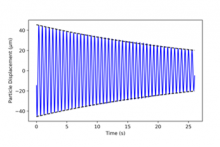
Abstract
We show that a magnetically levitated microsphere in high vacuum can be used as an accelerometer by comparing its response to that of a commercially available geophone. This system shows great promise for ultrahigh acceleration sensitivities without the need for large masses or cryogenics. With feedback cooling, the transient decay time is reduced and the center-of-mass motion is cooled to \SI{9}{K} or less. Remarkably, the levitated particle accelerometer has a sensitivity down to \SI{3.6e-8}{\mathit{g}/\sqrt{Hz}} and gives measurements similar to those of the commercial geophone at frequencies up to \SI{14}{Hz} despite a test mass that is four billion times smaller. With no free parameters in the calibration, the responses of the accelerometers match within \num{3}\% at \SI{5}{Hz}. The system reaches this sensitivity due to a relatively large particle mass of \SI{0.25}{\upmu g}, a low center of mass oscillation frequency of \SI{1.75}{Hz}, and a novel image analysis method that can measure the displacement with an uncertainty of \SI{1.6}{nm} in a single image.